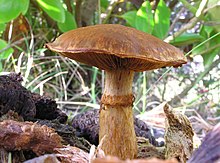Anannulus is the ring-like or collar-like structure sometimes found on the stipe of some species of mushrooms. The annulus represents the remnants of the partial veil, after it has ruptured to expose the gills or other spore-producing surface. It can also be called a ring which is what the Latin word annulus directly translates as.[1] The modern usage of the Latin word originates from the early days of botany and mycology when species descriptions were only written in Latin. Outside of the formal setting of scientific publications which still have a Latin requirement,[2] it will often just be referred to as a ring or stem ring in field guides[3] and on identification websites.[4]

The way in which the structure and appearance of rings is described can vary with author and the description may only note the existence of a ring without providing specific information in cases where the ring lacks any notable features that would be useful to distinguish between similar species. Ring shapes and structures can also vary between specimens of the same species and change with the age of the mushroom so multiple descriptions are sometimes used. Even in species with distinctly identifiable rings they may not always be present or perfectly match descriptions so it can be beneficial to have multiple specimens to compare at different states of maturity.[4]
Some rings may be persistent and remain through the life of the mushroom or they may disappear with age. Such rings have a variety of synonymous terms associated with them such as fleeting,[5] ephemeral,[4] evanescent,[6] transient,[7] fugacious[8] or impermanent. These rings may peel away from the stem, fall apart or simply fade into the stem surface as it matures. Rings may also be described as fragile,[9] meaning easily torn or damaged and whilst some fragile rings could be considered permanent if undisturbed they are often likely to vanish due to their fragility. Some rings may be fixed in place and firmly attached to the stem whilst others may be movable[9] or mobile with the ability to slide up and down the stem either by hand or just falling down naturally with age. Fragile and movable rings can appear to vanish so examining the stem for traces of a ring zone[10] (or annular zone)[11] or the base for a detached ring can sometimes be helpful. Various combinations of these terms can be used to best describe the nature of the ring in a particular species.
Some common descriptions of the type of ring include:[12]
The texture of the partial veil can exhibit specific characteristics which can aid in identification and these may persist in the ring once the cap has detached from it. These details may be similar to that of the cap surface or distinct from it.
Texture/surface descriptions include:[12]
The position of the ring can be an important factor to observe to aid in identification although it is often not included in descriptions as for some species it can be quite variable. The position may appear different from specimen to specimen due to the height of the stem or the age of the mushroom and in species with movable, fragile or otherwise detachable rings it may not always be a reliable factor to observe. However for species which otherwise look quite similar but exhibit differences in colouration, texture or staining above or below the stem ring, the position can be a useful factor to note.[4]
The common descriptions of positions are:[12]